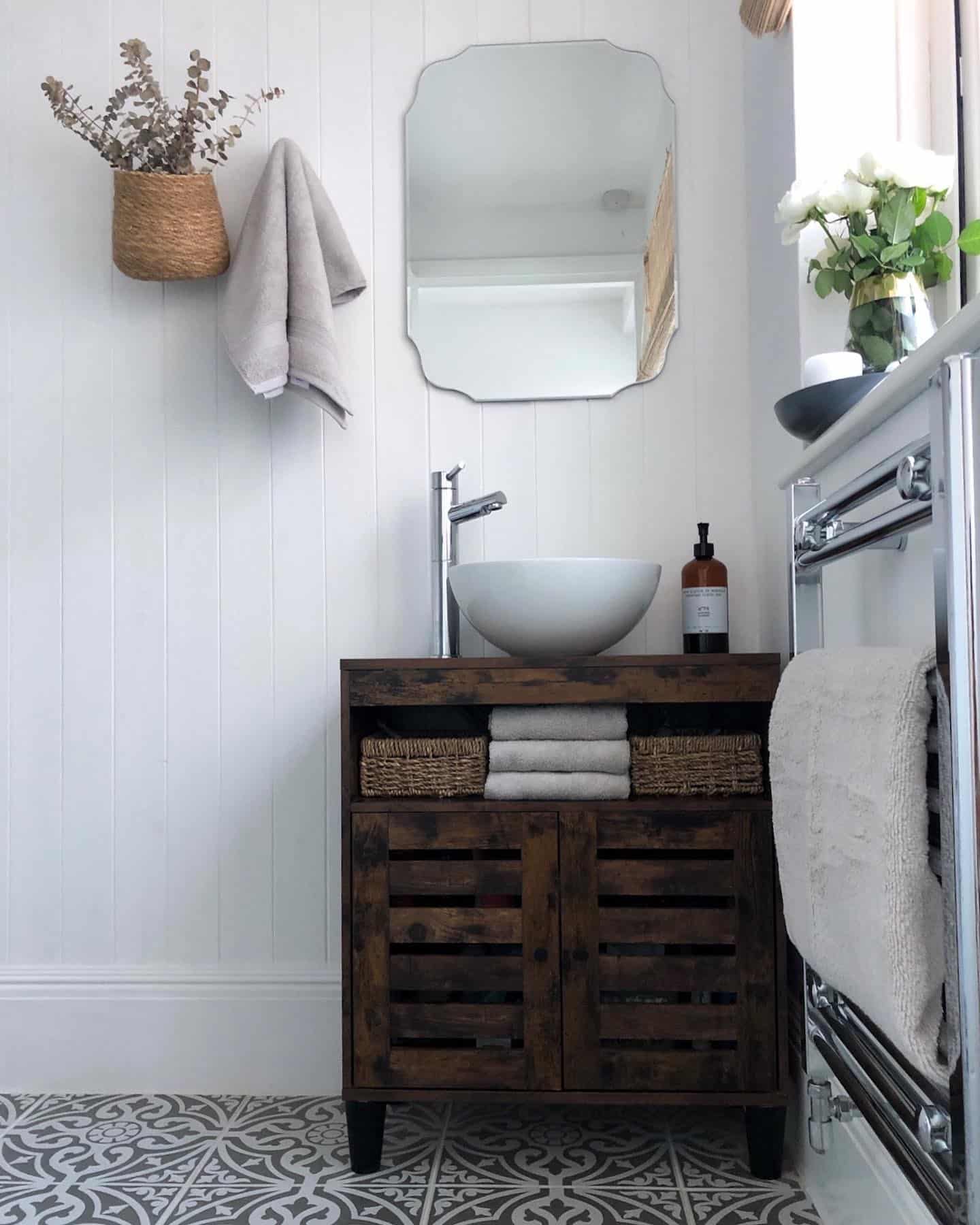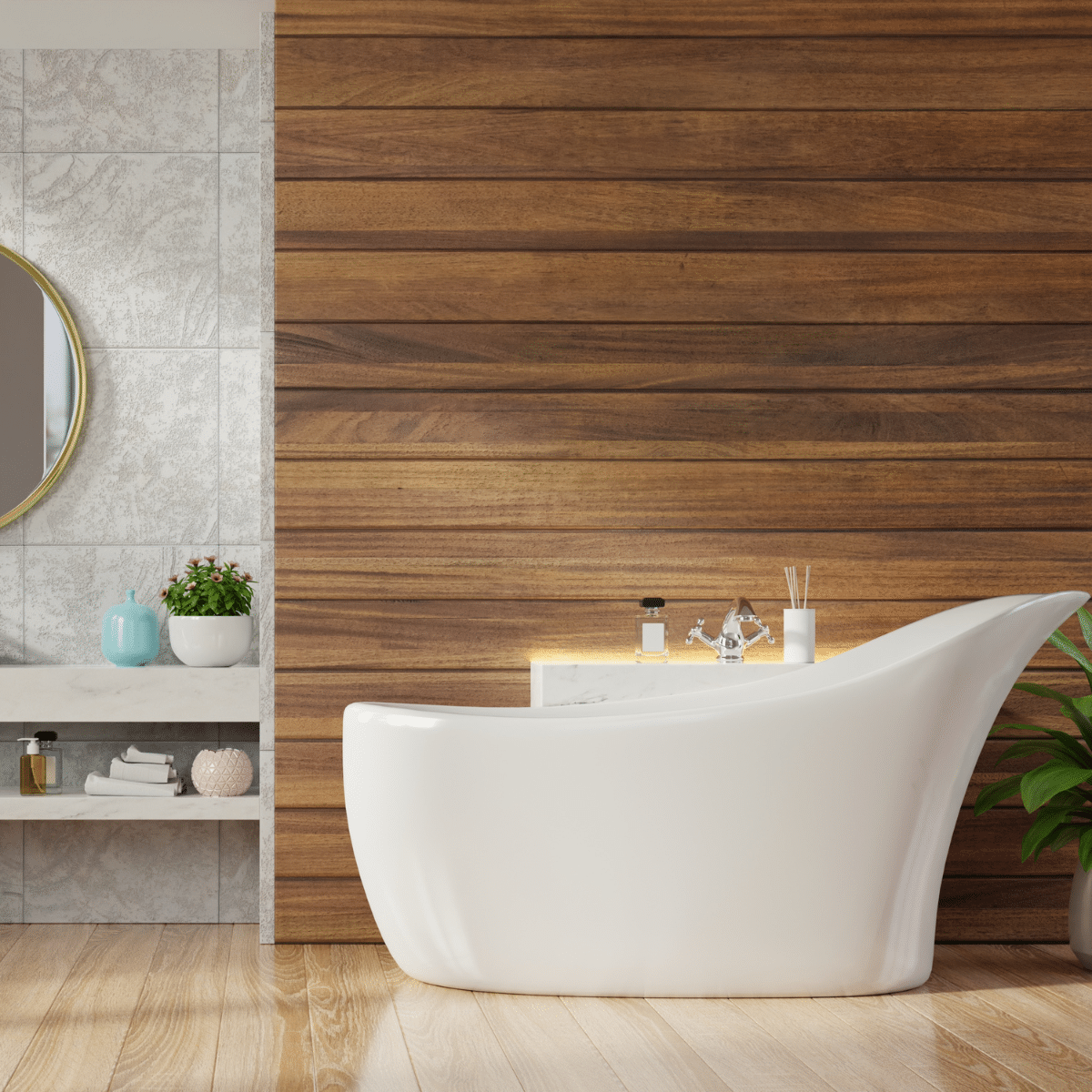
Looking for a bathroom wall covering instead of tiles? Whether it’s to counteract bathroom crumbly walls, keep costs down, or to avoid the maintenance of cleaning mould out of the grout each week – there are options.
When it comes to bathroom wall coverings, traditional tiles is all but one solution when it comes to covering a bathroom wall.
Bathroom tiles can look great, but they can become incredibly expensive, and they aren’t well suited to all types of bathrooms.
There’s a couple of problems with using tiles as a bathroom wall covering that I detest. It does not matter how often you dry your walls after a shower, the grout, and sealant will still get mouldy. The once pristine white grout is only pristine for a couple of months before it needs to be redone, did I mention it’s also an absolute pain to clean?
The other issue is if you have damaged walls in a bathroom, this would become an almost impossible surface to apply tiles to, or leave painted.
After experiencing both of the issues in my flat, and terraced house which was virtually crumbling at the top of the walls I’ve found some fail safe ideas for covering damaged walls in bathroom, as well as plenty of ideas for bathroom wall covering instead of tiles that practice both function and aesthetics.
Bathroom Wall Covering Instead of Tiles Ideas
Panelling
Bathroom tongue and groove panelling has definitely seen a revival over the last couple of years and it is no longer being used as just a means to keep out damp and to provide insulation. Although, this is one of the reasons it makes a great alternative to tiles.
Panelling can’t be used within an enclosed shower area, but it provides a super wall covering that’s moisture resistant and looks amazing too.
The beauty of panelling is that it starts at an affordable cost, it rises with the type/style and if you go for pre-cut sheets/cut to size sheets.
For us, it was the best solution to cover up the top of a crumbling wall, actually providing more integrity to the surface. Out of sight, out of mind rings a bell here, but it’s honestly a great cover up for all sins.
There’s a few things you need to do for it to be a good bathroom covering though. You should opt for moisture resistant panelling, and it must be primed and painted in a washable, bathroom paint which makes it suitable for use in a room such as a bathroom that experiences high humidity, and moisture.
In addition to this, if space isn’t a premium in the bathroom, make sure the panelling is attached to a frame, and not directly onto the wall.
It certainly can be fitted against a wall, but you are at the mercy of temperature changes. As soon as the temperature lifts, the wood will move and expand causing cracks in any caulk, and paint. You then need to wait for more ambient levels to re-paint and caulk. It’s a constant up-keep job, so if you can, always fit it to a frame.

Multipanel Bathroom Wall Covering
Until our bathroom renovation, I honestly had no idea there was other alternatives to tiles for a shower/bath area.
The biggest issue with traditional tiles is the grout, upkeep and cleaning of them. We wanted white brick style in the shower cubicle, and it was only when our plumber introduced Multipanel shower wall panels to us that I knew exactly what we needed. Perhaps this might be my favourite bathroom wall covering instead of tiles option out of the bunch.
I must admit, I was slightly dubious at first because tiles DO look great, and multipanel panels are essentially sheet panels that are made to look like tiles, on some of the designs anyway.
I think the best part of choosing the panels is the HUGE range they have. Most bathroom showrooms allow you to look at them in person so you can get an idea of what they look like. We opted for the type that looked like white brick tile, whilst you don’t get the same texture, it’s so much more understated, and modern.
The best bit? No damp, no mould and you don’t have 10’s of lines worth of grout to clean. This is a waterproof wall covering for bathrooms, and it’s revolutionary.
It’s easy to fit, can even be installed over old tiles so if you wanted a cheap bathroom wall covering without the expense of removing existing tiles, then you can. They also come with a 30 year guarantee which is just amazing.
Our multipanel shower panel has been in for 6 months now, we’ve had 0 issues, no mould and it’s the easiest thing to clean ever.
I’d probably go to say that from my current experience, it’s by far the best alternative to tiles.

Vinyl Wall Covering
A cheaper alternative to multipanel is vinyl wall covering. You can even use vinyl flooring on the walls, it’s a more affordable option, it will repel water, and like the multipanel, it’s easy to clean and doesn’t create the issue of mould in between the grout.
I’ve not personally used vinyl as a wall covering before, but where the cost can be considered cheap, it does leave the question as to how durable, and long lasting this wall covering solution is.
It’s a great solution if you’re looking for something cheap to temporarily update a bathroom space.

Paint
Paint still remains a hugely popular choice of wall covering in a bathroom. It’s just not an option for badly damaged walls, unless they can be repaired and plastered.
Paint is a cheap wall covering solution, and it’s easy to change when you get bored of it. Just ensure you always opt for a washable, bathroom paint that can easily be wiped down, and is moisture resistant.

Microcement
Microcement is one of the newer bathroom wall covering options on the market, but it’s growing in popularity for its modern, minimalist and super sleek design.
But, what is it? Microcement is a decorative coating composed of cement, aggregate, resins and pigments. It can be laid on top of damaged walls, and existing tiles without removal, or plastering.
This makes it such a versatile wall covering for most bathrooms, and it’s available in a range of colours to suit your scheme. It also has an extraordinary resistance to environmental humidity so it really is perfect for use in a bathroom.
The drawback? This is considerably more expensive than other wall covering options, but it does seem to offer a durable, hardwearing solution that’s also easy to clean. As microcement is still a fairly new covering, there are very few professionals installing this, currently.
For a spa like bathroom that’s minimalist, this could be the perfect bathroom wall covering choice for you.

Image Credit: @thebungalow_reno
Wallpaper
For more traditional, period style bathrooms, wallpaper is a great choice in a bathroom. You can really get a glimpse of your personality and home decor scheme when picking wallpaper, and you can create a fun, colourful space with it.
Whilst it can add strong visual impact to a space, as shown below… It’s not the best covering for a place like a bathroom which experiences moisture and humidity, this can lead to bubbling if not hung correctly. Always look for bathroom specific wallpaper that’s washable, and designed for a bathroom.

Image Credit: @manwithahammer
Final Thoughts
When it comes to a bathroom wall covering instead of tiles, there really are some great alternatives out there.
From the more expensive end of the spectrum with Microcement to keeping it affordable and cheap with standard paint, there’s a range of wall coverings suited to your budgets and taste.
If you’re looking to quickly lift your walls without thinking of the long term you can’t go wrong with paint. For something more long term that’s durable and holds a good warranty, multipanel is a fantastic solution that’s made to last, looks great and is available in so many styles and colours.
If you’ve got damaged walls and are wanting to keep costs down, multipanel panels and panelling are probably two of the best choices that hide a cardinal of sins, and will protect the integrity of the walls too. Which bathroom wall covering instead of tiles option is your favourite?
